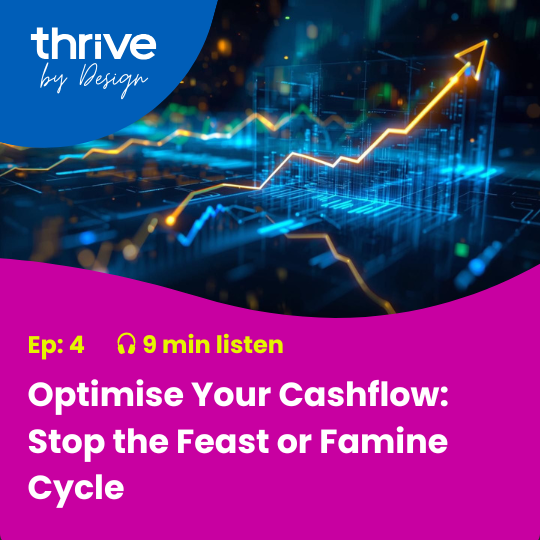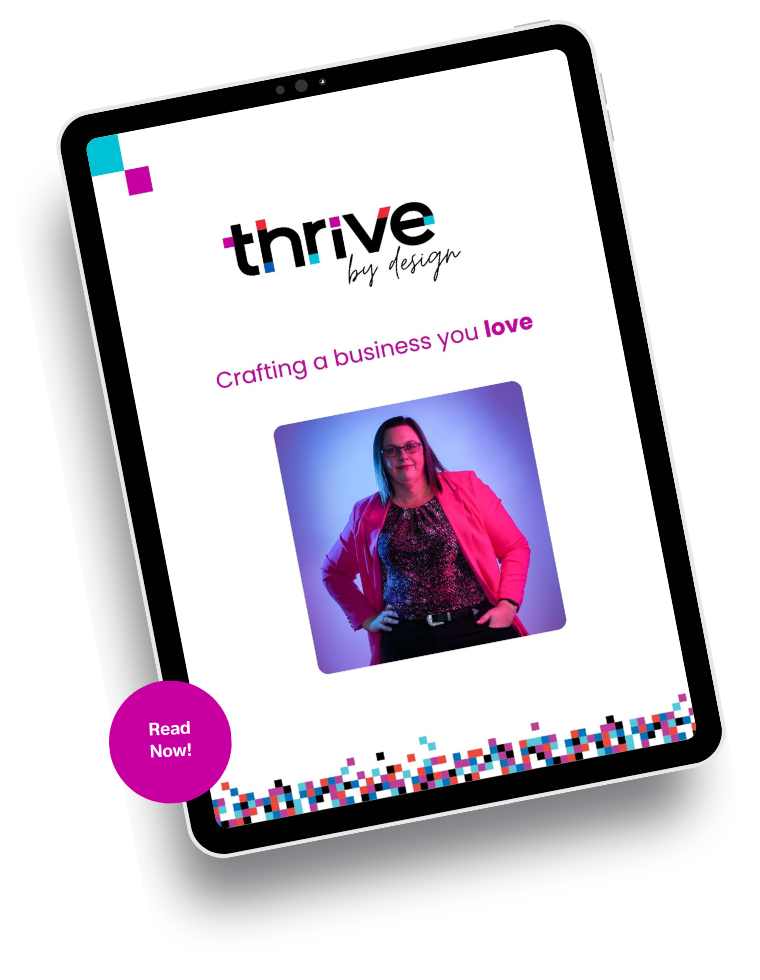Introduction - The Rollercoaster Ride
You know that feeling when cash is flowing, clients are coming in, and you think, “Finally. We're making progress”.
You might even take a breath, pay yourself properly for a change, and start thinking about growth - hiring, upgrading your systems, maybe taking a weekend off.
But then suddenly… it shifts.
A couple of invoices are late.
A project delayed.
Expenses still roll in, and your bank balance starts shrinking faster than you can refill it.
That moment, when the calm turns to chaos, that’s what I call the feast or famine cycle.
It’s exhausting. It messes with your confidence. And it’s one of the biggest reasons service entrepreneurs feel stuck - even when their business looks successful on paper.
But here’s the truth: cash flow swings aren’t a sign that you’re bad with money or that your business isn’t viable.
They’re a sign that your system for managing money hasn’t caught up with the size and pace of your business yet.
So in today’s episode, we’re going to fix that.
We’ll break down why this cycle happens, how to spot it early, and what practical steps you can take to smooth it out - so you can finally feel calm, confident, and in control of your cash.
Why Cash Flow Chaos Happens
Let’s talk about where cash flow chaos really starts.
Cash flow chaos doesn’t usually come from one big mistake; it’s a bunch of small leaks that compound over time.
Here are some of the big ones I see again and again with service entrepreneurs:
1. You’re running the business from your bank balance
You open your banking app in the morning. If there’s money there, things feel fine. If not, panic sets in. That’s not cash management - that’s emotional survival.
2. You’re flying blind
You don’t have a clear view of what’s coming in or going out over the next few months, so every bill feels like a surprise.
3. Clients are paying late or on their own schedule
You’ve done the work, but the money’s sitting in someone else’s account while you’re juggling payroll or tax.
4. Timing mismatches
Maybe all your big costs - wages, subscriptions, supplier bills - hit before the income lands. That’s a structural issue, not a sales one.
And here’s the kicker. Most businesses look profitable but still run out of cash because of timing.
Profit doesn’t pay your bills. Cash does.
When you don’t have visibility or rhythm around how cash moves, you end up reacting. Robbing Peter to pay Paul. Delaying your own pay. Making short-term decisions that hold your growth back.
So, let’s shift that.
What “Optimising” Cash Flow Really Means
Optimising cash flow isn’t about cutting costs or hoarding cash.
It’s about designing how money moves through your business, so that it supports growth and stability.
I like to think of it as creating a rhythm:
Cash In: How and when money comes in - your invoicing, deposits, retainers.
Cash Held: What you intentionally keep aside - for tax, for profit, for your own pay.
Cash Out: What leaves the business - your expenses, payroll, and investments.
When you manage the rhythm, you can predict your peaks and troughs before they happen. You’re not caught off guard, you’re prepared.
And that gives you something priceless - peace of mind.
When your cash flow is smooth, you make better decisions. You hire confidently. You invest in growth without that knot in your stomach.
Because you know what’s coming.
That’s what optimising cash flow really means. Not control for control’s sake, but clarity so you can lead with confidence.
The 3 Levers to Smooth the Cycle
Alright, let’s get tactical.
There are three big levers to pull if you want to get off the cash flow rollercoaster for good.
1. Speed up your inflows
Tighten your payment terms. If you’re at 30 days, consider 14. Even better if it's 7.
Ask for deposits or progress payments. You’re not a bank.
Automate invoicing and reminders. Tools like Xero can do this seamlessly.
Offer easy payment methods. If paying you is a hassle, people delay it.
Here’s a mindset shift: your clients’ payment habits are often a reflection of your boundaries. When you make it clear and easy, they will respect it.
2. Slow down or plan your outflows
Negotiate supplier terms or switch annual costs to monthly to even things out.
Build a rolling 90-day forecast so you can see cash dips before they happen.
Separate tax, profit, and operating cash into different accounts. That simple habit alone stops 80% of stress around cashflow.
Think of it like having envelopes for your business. Every dollar has a job, and you know where it’s going.
3. Build your cash buffer
This one’s a game changer.
Even one month of expenses gives you breathing room, and every month you add to it, the stress melts away a little more.
Start small - even 2–5% of income set aside consistently adds up faster than you think.
That buffer is what turns panic into strategy. It lets you make decisions from choice, not desperation.
An Example - The Service Business Reality
Let’s make this real with a quick example.
Imagine you run a design or consulting business. Projects take 4–6 weeks, and you bill on completion.
Meanwhile, your team’s wages, software subscriptions, and rent are due every month - regardless of when clients pay.
If your average work-in-progress time is 30 days, and clients take another 30 to pay, that’s a 60-day cash gap.
That means you’re essentially bankrolling two months of work before you see a cent.
Optimising that could look like this:
50% upfront, 30% halfway, 20% on delivery.
Invoicing automatically when milestones hit.
Following up proactively - not “hoping” they pay on time.
And here’s what happens when you do that:
Cash starts flowing consistently. You can plan wages, tax, and growth investments without holding your breath.
That’s how you move from chaos to calm.
Take Action - Get in the Driver’s Seat
Here’s your takeaway this week: build a simple 90-day cash flow forecast.
You don’t need fancy software. A spreadsheet or even paper works.
List what’s coming in, what’s going out, and when.
Ask yourself:
Do I have enough cash to cover the next 3 months?
Where are the pinch points?
What can I do now to smooth them out?
When you can see your cash flow, you stop guessing.
You start making confident decisions.
And that confidence changes everything - for you, your team, and your clients.
Because when your cash flow is steady, your energy is steady. You show up differently. You lead differently.
Where To From Here…
So if you’re tired of the rollercoaster - the panic, the stress, the sleepless nights wondering if you can cover next week's payroll - know this:
You don’t need more clients to fix your cash flow.
You need more clarity around how cash moves through your business.
And when you design your cash rhythm intentionally - inflow, outflow, and buffer - everything changes.
You move from reactive to proactive. From chaos to calm. From surviving… to thriving.
Next week, we’re diving into how to unlock financial insights - the key to turning your numbers into decisions that actually move your business forward.
Until then, keep thriving - but do it by design, not by default.


